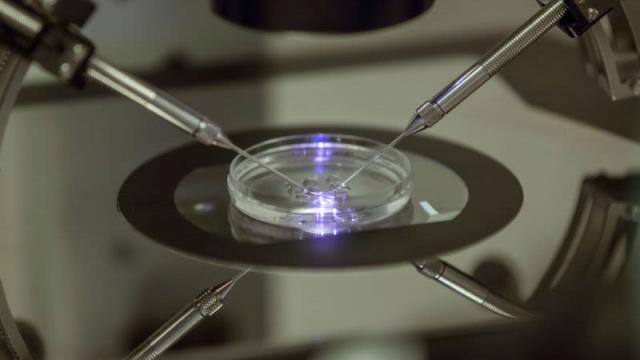The genome editing technology CRISPR revolutionised genetic engineering by allowing scientists to cut and paste tiny snippets of DNA with more precision than ever before. Now, one of the groups responsible for that technology has harnessed the power of CRISPR to also edit RNA, a molecule that, like DNA, is essential in the coding, regulation, and expression of genes. This development could eventually allow scientists to alter the expression of genes in the human body without having to change the genome itself.
Image: AP
“Editing at the level of RNA has several advantages,” Feng Zhang, a scientist at the Broad Institute and senior author on a new paper published today in Science, told Gizmodo. “It’s more flexible than making a permanent change to the DNA, which has important implications for therapeutic use, and it allows you to study and control a wide range of cellular processes, such as splicing, mRNA modification [and] signalling cascades.”
Along with DNA and proteins, RNA is one of life’s vital macromolecules, involved in both protein synthesis and the transmission of genetic information. In a cell, genetic information flows from DNA to RNA and then to proteins, with the RNA acting as a sort of arbitrar between the two. In recent years, though, our understanding of the role RNA plays has vastly expanded. Defective RNA, rather than DNA, has also been implicated as the source of some human diseases, including some cancers.
To edit RNA, scientists needed to create a new editing system. There are many different CRISPR enzymes, and most CRISPR genome engineering systems rely on one called Cas9. The RNA editing system developed by Zeng and his colleagues relies on a different enzyme, Cas13b. The system allows researchers to change a single nucleoside, or RNA letter, in an RNA chain in mammalian cells. They’re calling the system RNA Editing for Programmable A to I Replacement, or “REPAIR.”
Where the REPAIR system could be a game-changer is in allowing scientists to alter disease-causing mutations without actually permanently changing a person’s genetic code. By correcting problematic mutations to the letters that encode RNA, scientists could potentially reverse mutations without causing permanent change to the genome, since RNA degrades naturally over time.
“This is a significant advance since it adds another dimension to [research] and editing capabilities,” said Eric Topol, a geneticist at the Scripps Research Institute, in an interview with Gizmodo. “It will help in determining which genes are essential, and especially the function of non-coding RNA which is often so elusive, difficult to understand. On the medical side the advantage is temporal intervention since RNA editing is transient and reversible — many medical conditions might benefit from such a specific timed, short-term editing process.”
Of course, Topol added, all this is theoretical — so far it has only been tested on human cells in the lab, and not on actual human beings.
The new technique does have some serious limitations. For one, explained Zhang, they have only figured out how to use the system to make a single base change. The system is only able to reverse Gs that have mutated to become As, a mutation tied to diseases including Duchenne muscular dystrophy and Parkinson’s disease.
“Although very common in genetic disease, [it] is only one of the possible 12 nucleotide edits [i.e. base changes] that can be made,” he said. “We would like develop additional base editors to expand the suite of tools available.”
More interesting, perhaps, is the way in which RNA editing could reframe the ethical debate around gene editing. Many concerns stem from the fact that altering someone’s genome is permanent; an edit that comes with unintended consequences could last forever, and even be passed down through generations. For some diseases, though, editing RNA could offer a workaround.
